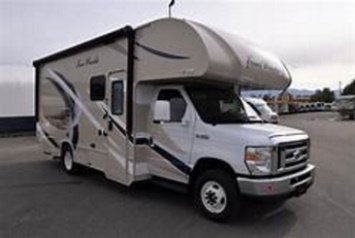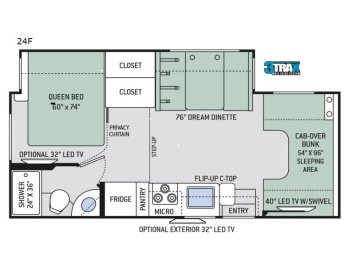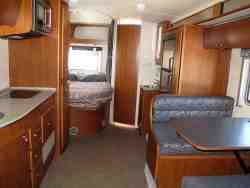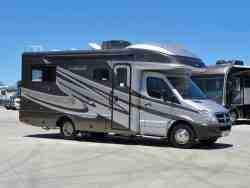All Motorhome Hitch Classes Will Have
A Specified Towing Capacity
Various Class C Motorhome towing hitch classes depend on, and are restricted to, the weight of the pulled vehicle involved.

The weight of the vehicle being pulled is limited to a universal rating called the Gross Combined Weight Rating (GCWR).
The GCWR is designated by Federal Standards at the time of construction of your Class C Motorhome Chassis. Trailer towing hitches have a class size ranging from class I to class V.
For Pulling Your Dinghy?
- Pulling A Dinghy:
- If you do do not have a hitch receiver on your rig and you intend to pull some type of vehicle, you must first determine what the weight of the pulled vehicle is going to be. This is necessary because you will need to match the hitch and tow bar assembly to the weight of your desired dinghy. This essentially breaks down into three steps:
- Determine the weight of the vehicle to be pulled.
- Determine the GCWR on your motorhome. Do not exceed this number.
- Ensure that the hitch and tow bar classification match the above weight constraints of the motorhome and dinghy.
- Determine the weight of the vehicle to be pulled.
- You must ensure that your choice of one of the motorhome hitch classes listed below will surpass the heaviest load you intend to pull. At the same time you will need to ensure that the total weight of both vehicles stays below the GCWR.
- If you already have a hitch receiver on your rig, you must understand the weight limitation parameters that are imposed on you. You must match these limiting parameters with whatever dinghy you decide to pull.
- If you already have a hitch receiver on your rig, you must understand the weight limitation parameters that are imposed on you. You must match these limiting parameters with whatever dinghy you decide to pull.
- If you do do not have a hitch receiver on your rig and you intend to pull some type of vehicle, you must first determine what the weight of the pulled vehicle is going to be. This is necessary because you will need to match the hitch and tow bar assembly to the weight of your desired dinghy. This essentially breaks down into three steps:
- Towing Capacities:
- Rated up to 2,000 lbs GTW (Gross Trailer Weight) with a maximum TW (Tongue Weight) of 200 lbs.
- Utilize a receiver hitch opening of 1-1/4" x 1-1/4".
- To be used with class I accessories, such as bike racks, cargo carriers, ball mounts and tube covers.
- 1-1/4" x 1-1/4" class II accessories should not be used with class I hitches.
- 1-1/4" x 1-1/4" class II accessories should not be used with class I hitches.
- Requires a manufacturer recommended drop towing hitch (drawbar) or ball mount to tow a small trailer.
- This may be sold separately or be included.
- This may be sold separately or be included.
- Utilizes a 1/2" pin to secure ball mount.
- Requires a hitch ball with a 3/4" diameter shank.
- Available in a square and round tube design.
- Rated up to 2,000 lbs GTW (Gross Trailer Weight) with a maximum TW (Tongue Weight) of 200 lbs.
- Towing Capacities:
- Designed for light duty towing and is rated at less than 3,500 lbs GTW with a maximum TW of 350 lbs.
- Utilizes a receiver hitch opening of 1-1/4" x 1-1/4".
- To be used with class I and class II accessories, such as bike racks, cargo carriers, ball mounts and tube covers.
- Requires a manufacturer recommended drop towing hitch (drawbar) or ball mount to tow a small trailer.
- This may be sold separately or be included.
- This may be sold separately or be included.
- Requires a hitch ball with a 3/4" diameter shank.
- Available in a square and round tube design.
- Designed for light duty towing and is rated at less than 3,500 lbs GTW with a maximum TW of 350 lbs.
- Towing Capacities:
- This hitch is designed for trucks, vans, motorhomes, and SUVs.
- Rated up to 6,000 lbs GTW with a maximum TW of 600 lbs.
- Utilizes a receiver hitch opening of 2" x 2".
- Has much greater utility function than the I and II hitch classes. The class III hitch will carry more equipment and pull a larger load.
- Has much greater utility function than the I and II hitch classes. The class III hitch will carry more equipment and pull a larger load.
- Allows for more gear to be carried or towed.
- Works with all Class III accessories, such as bike racks, cargo carriers, and tube covers.
- Class I and Class II (1-1/4") hitch accessories can also be used with an adapter.
- Works with all Class III accessories, such as bike racks, cargo carriers, and tube covers.
- Requires a manufacturer recommended drop towing hitch (drawbar) or ball mount to tow a small trailer.
- This may be sold separately or be included.
- This may be sold separately or be included.
- Utilizes a 1/2" pin to secure ball mount.
- Requires a hitch ball with a 3/4" diameter shank.
- Available in a square and round tube design.
- This hitch is designed for trucks, vans, motorhomes, and SUVs.
- Towing Capacities:
- This hitch is designed for trucks, vans, motorhomes, and SUVs.
- Rated up to 12,000 lbs GTW with a maximum TW of 1000 lbs.
- Has a greater cargo carrying capacity than the class I, II, or III hitch.
- Can utilize all Class III and IV accessories.
- With appropriate adapters (1-1/4"), can utilize all Class I and Class II hitch accessories.
- Can utilize all Class III and IV accessories.
- Ball mounts sold separately.
- Will work with hitch balls with 1" diameter shank.
- Class IV hitch balls require a 1-1/4" diameter shank.
- This hitch is designed for trucks, vans, motorhomes, and SUVs.
- Towing Capacities:
- To be used on heavy-duty trucks and/or vans to tow large trailers.
- Requires a 2-1/2" x 2-1/2" receiver hitch opening.
- Designed to be used for especially heavy towing.
- Rated up to 17,000 lbs GTW with a maximum TW of 1,700 lbs.
- Can use Class III or IV accessories with proper adapter.
- Can use Class III or IV accessories with proper adapter.
- Class V ball mounts sold separately.
- To be used on heavy-duty trucks and/or vans to tow large trailers.
Return To Top Of Page
Leave All Motorhome Hitch Classes Will Have A Specified Towing Capacity And Return To Motorhome Dinghy Towing
Leave All Motorhome Hitch Classes Will Have A Specified Towing Capacity And Return To Home Page
Your Stories
Onan AC Generator Wouldn't Start
1995 Tioga Montara Had a Leak - Ouch!
A Simple Way To Put An Elecrtrical Thermostat On A Small Space Heater In A Truck Camper!
A Great Destinaton, With An Unexpected Outcome!

2018 Thor 21F Four Winds Class C Motorhome

2018 Thor 21F Four Winds Class C Motorhome
2010 Fleetwood Pulse 24D
Class C Motorhome

2010 Fleetwood Pulse 24D
Class C Motorhome
Above Graphics Courtesy of:
http://www.DeMartini.com
| Gasoline Prices |






